Beat wedding-shoot anxiety: Wedding photography tips from world-class pro Scott Robert Lim
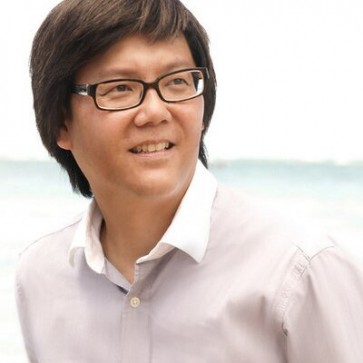

Hot summer nights have always been a popular time for love-stricken souls to pop the question...
"Can you shoot my wedding?”
If you’re a serious amateur photographer, getting asked to photograph your friends’ big day—or volunteering to do it—can be a thrill and even a great first step toward a new career. It can also be a total freak-out. Sure, you know your way around a camera, but photographing a once-in-a-lifetime event raises the stakes big time.
We turned to destination wedding superstar Scott Robert Lim for some tips to help you get past the jitters and capture lifetime memories, regardless of whose wedding you're shooting. Now a world-traveling wedding photographer and instructor, Lim jump-started his own career by shooting weddings for friends. He talked with us about what first-timers need to know, how to build a career-launching portfolio, and why he traded in his hefty SLRs for a flyweight mirrorless kit.
Aimee Baldridge: How did you become a wedding photographer?
Scott Robert Lim: I started my photography career at the young age of 37. It was quite out of desperation. My wife and I had agreed when we got married that she was going to quit her job and manage the family, because that was her dream. It wasn’t her dream to be a high-powered accountant. But she was making all the money, and I was this struggling, lost person. I had different businesses that I was trying, but nothing was really sticking. So when we decided to have a family, the situation was: My wife’s quitting her high-paying job, and we’re going to be living off of $10,000, owning a house in Los Angeles. I don’t think this is going to work too well.
So I thought, “Well, I really love photography, and I remember paying my wedding photographer a lot of money, so let me see if I can shoot weddings.” I e-mailed all my friends, and one replied and said, “I’ve got this friend who’s on a budget, and it looks like you’d be a good fit for them.” I was so scared to death that I hired two of my friends to shoot with me. After all of the upsells, I believe I took home $600. I was like, “Wow, this is amazing! I’m doing something I really love, and they’re paying me $600!” I was hooked. And then before you know it, I was making $10,000 per wedding and being flown all around the world.
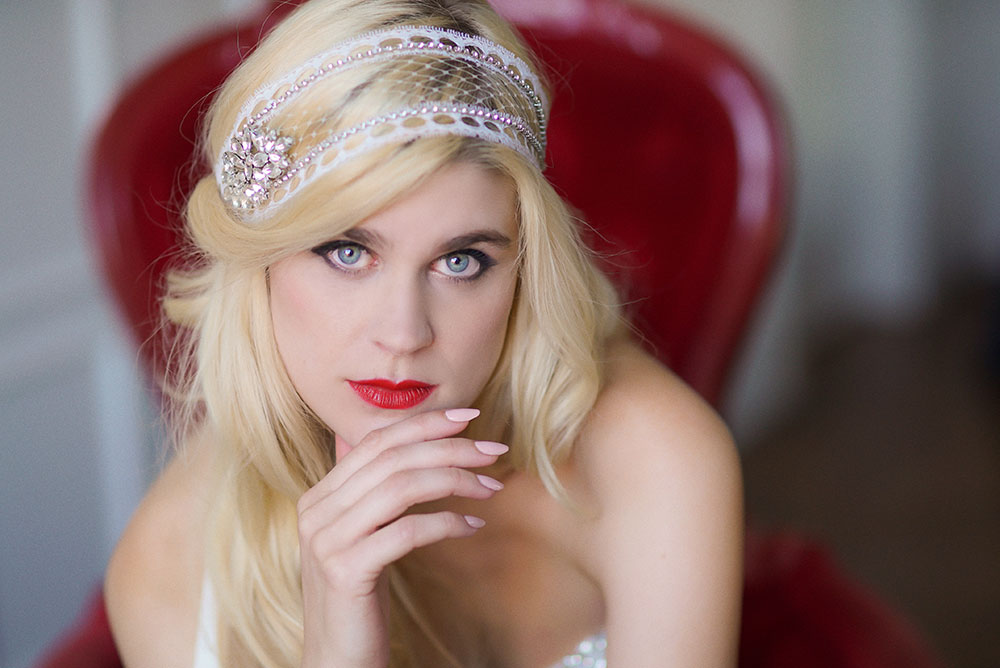
Photographed with a Sony a7S and Zeiss® Planar T* 85mm f/1.4 ZA lens at ISO 400 with an f/2.0 aperture and 1/200 second shutter speed. Photo © Scott Robert Lim.
AB: What would you tell someone who’s starting out the way you did? How should photographers prepare to shoot their first wedding?
Scott Robert Lim: Don’t be scared. Have fun and give it your all. You should understand the basics of photography—the exposure triangle, how to get a good exposure, how to shoot in manual mode. You have to be confident, and maybe hire a friend to take some second angles.
Try to allow your subjects to have fun. You probably can’t pose them, because posing is such a refined art. But what you can do is make them interact. If you get them moving and having fun and connecting with each other, you’ve got a shot at it. Sit back and take pictures while they’re interacting and showing expression.
But that takes skill too. You can’t just say, “Hey, go over there and smile and laugh with each other!” Your photography, especially wedding photography, is a mirror to your soul. I can review a person’s portfolio and see their personality. And a wedding is all about a myriad of expressions—happiness, romance, sexiness, elegance. So you have to bring those qualities in yourself out in order to get it.

Photographed with a Sony a7 and Tokina 19-35mm f/3.5-4.5 lens at ISO 400 with an f/5.0 aperture and 1/250 second shutter speed. Photo © Scott Robert Lim.
AB: How do you use your personality to make people comfortable in front of the camera? Do you have any advice for people who don’t have experience doing that?
Scott Robert Lim: That’s probably one of my greatest strengths—my personality. My strength is working with people and making everybody have fun. Now, let’s say you’re not one of those people. What you can do is hire somebody who is. With any business, you’ve got to look at your skill set and realize what your strengths are, and then be honest and recognize your weaknesses. If you’re not one of those chatty, social people, then find a friend who is who can help you with that, and you’ll have great success.
I see wedding photographers as being like directors of a movie. You’ve got this thing going on, and it’s great, but sometimes you have to step in and exaggerate an emotion to get it on camera. The more you can see yourself as a director and create situations, create the lighting, and create the mood, the better your chance of having a great wedding shoot.
Photographers who shoot other kinds of subjects, like landscape or street photographers, aren’t used to intervening that way. They think of themselves as observers and not people who are there to shape events. But the difference between a really good wedding photographer and an OK one is that the really good photographer becomes proactive.
On a wedding day, you have to get great shots on demand. You can’t wait for the perfect moment. You have to get it now, while there’s no light. If the bride has just been crying her eyes out because she’s frustrated, and in ten minutes you’ve got to take a shot of the couple, you’ve got no choice. You can’t wait for them to get happy. You have to make them happy now. So you have to learn how to be proactive, versus reactive.
New wedding photographers might want to sit down and create some scenarios in advance: Have them hold hands and run, or tell them things like, “Look at each other as if this were the last time you’re ever going to see each other. Now kiss.”
AB: Whoa, that’s kind of heavy.
Scott Robert Lim: Yeah. But the great wedding photographers have all these tricks to how they do that kind of stuff. Basically, it’s about emotion and exaggerating that emotion to get it on camera.
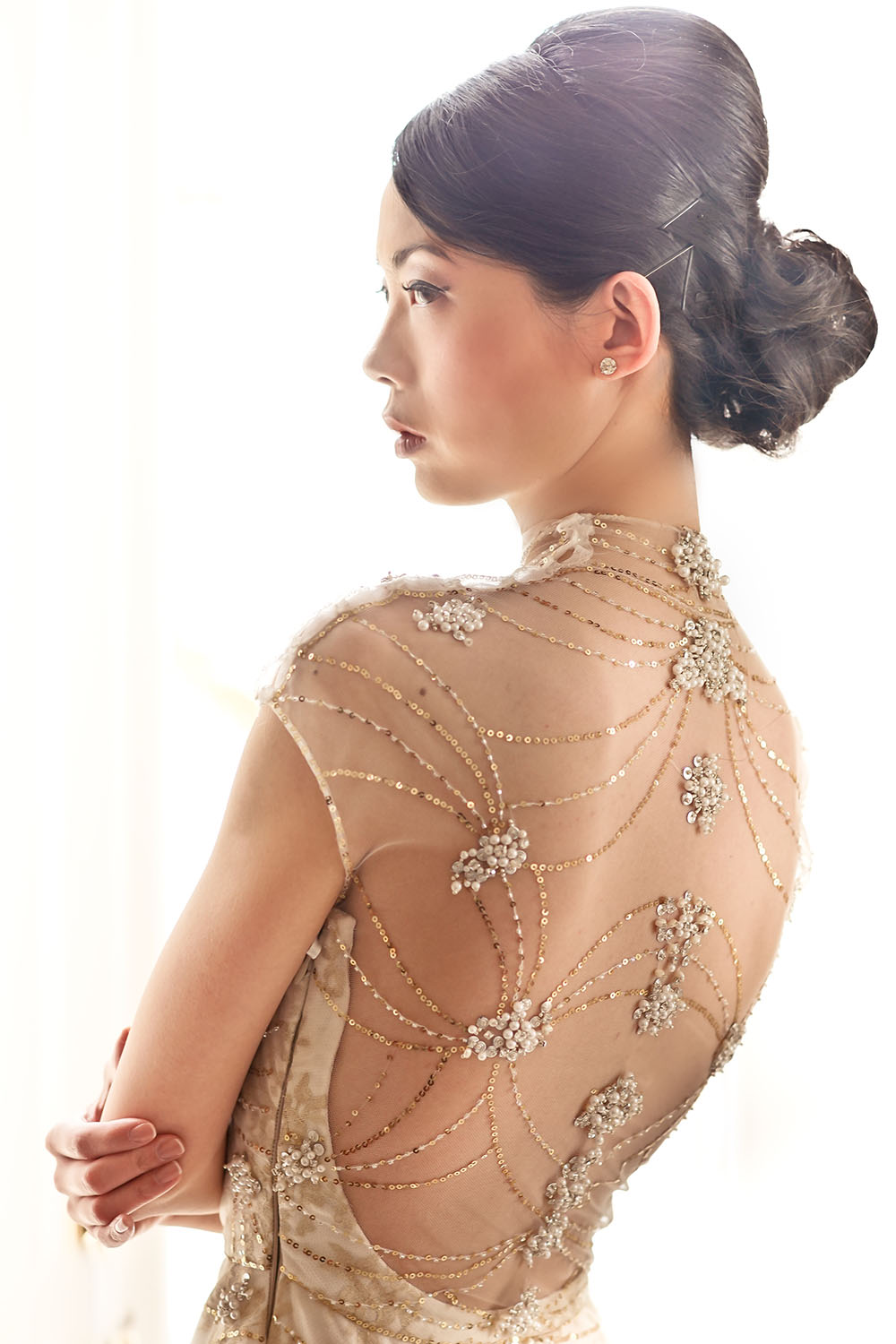
Photographed with a Sony a7 and Zeiss® Planar T* 85mm f/1.4 ZA lens at ISO 100 with an f/3.2 aperture and 1/160 second shutter speed. Photo © Scott Robert Lim.
AB: Speaking of cameras, what are you shooting with these days?
Scott Robert Lim: I’m going all mirrorless. I’ve made the switch. You know the big, heavy DSLRs? I used to use those, and I’ve completely switched over to the smaller, more compact mirrorless cameras. I use the Sony α7S and α7 II, which is the smallest full-frame camera out there on the market.
After doing wedding photography for 15 years, it can be very taxing on your body with all the equipment you’re carrying around and all the massages and stuff you need afterwards. This equipment has really been a godsend. It’s so small, light, and portable, yet high quality. I love it.
AB: Why did you switch to mirrorless cameras in the first place? Were there reasons aside from the light weight?
Scott Robert Lim: It’s not just because they’re mirrorless. It’s also their Live View feature, which lets you see the exposure before you take the picture. After shooting for 15 years, it’s hard to find things that improve you a lot. A new technique might improve you 5 percent or 2 percent, and you’re happy with that. But Live View makes me 30 to 40 percent faster and more efficient, even at this point in my career. I can’t go back.
If you’ve got a complicated lighting situation—let’s say the bride is by a window with bright light coming in—your camera has no idea what to do. Are you focusing on the outside? Are you trying to get the exposure for the person on the inside? If you can actually see what you’re getting with Live View before you shoot a complex lighting situation, that’s a definite advantage.
I like to tilt the screen, too. The best portraits are when you’re shooting down on your subject, and you’ll find that some of the best photographers in the world are tall. Because I can see the back of my camera and see the exact exposure before shooting, I can raise the camera above my head, and then I’m over six feet tall. So I can shoot higher, and I can also flip the screen out and shoot on the ground without putting my stomach on the ground. Features like that allow me to be more creative.
You can also get an adapter that will mount just about any lens on a mirrorless body. And because the viewfinder is electronic, it has something called focus peaking for manual focus. It’s one of the greatest features ever. It displays a colored outline around any object that’s in focus. I prefer using focus peaking instead of autofocus when I’m in a very low light situation, because low light makes it hard for your camera to autofocus.
That’s the thing with a wedding: You’re going to get situations where the light is very minimal. If it’s the first dance or something else crucial that you need to get, you need to feel comfortable switching over to manual.
AB: What kind of lighting do you use during weddings?
Scott Robert Lim: I’ve actually manufactured my own lighting equipment. I’m kind of known as an expert in small, portable lighting. All I use for lighting is manual flashes, a video light, and a shoot-through umbrella. That’s it.
Like I said, the basics are important. So learning how to use a manual flash, how to create big light, and where to find good light—those basics can take you very far. People are always looking for that next gadget that supposedly is going to make their life easier, but lighting is complicated, and nothing is really going to make it easy. You have to just learn it. Once you do, you won’t need a lot of gear to take great photos with lighting.
AB: And you can work with all of the same lighting that you used with DSLRs when you’re shooting with your mirrorless cameras?
Scott Robert Lim: Oh yeah. There’s not one thing that I can’t do with my mirrorless cameras and the lighting equipment that I have that I did with the DSLRs.
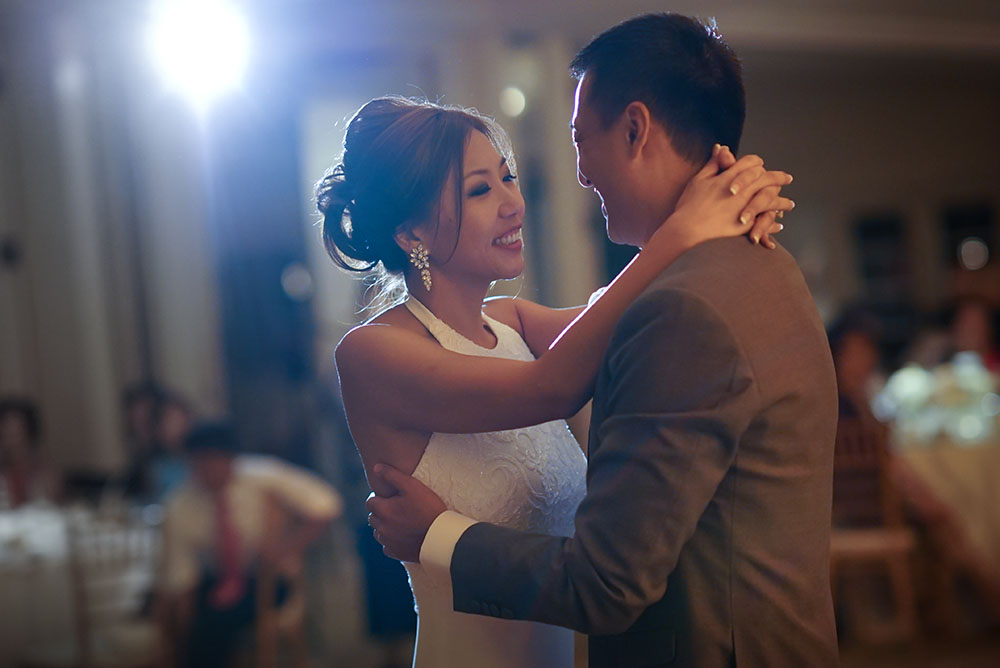
Photographed with a Sony a7S and Zeiss® Planar T* 85mm f/1.4 ZA lens at ISO 4000 with an f/2.0 aperture and 1/320 second shutter speed. Photo © Scott Robert Lim.
AB: What are your favorite lenses for shooting weddings?
Scott Robert Lim: I like to carry two bodies with two completely different lenses on them, so that I’m prepared for any situation. I don’t have to think about changing lenses. I just switch cameras, and I get much better coverage that way.
I usually put a 16-35mm wide-angle lens on one camera body, and then I put a fast prime lens, a portrait lens, on the other. My favorite is an 85mm, so I use the f/1.4 85mm lens that Sony makes, with an adapter. I also just ordered a Zeiss lens that they’re making for the new mirrorless cameras.
A fast prime lens is the best thing you can get if you’re shooting a wedding. You can get a 50mm fast portrait lens for around $100. You don’t have to buy the $1,000 one if you don’t have the budget (although it’s nice to have that). Why is it important? Because you can shoot at f/1.8 and blur out everything in the background. It could be a hideous Elks lodge or Motel 6 situation where you’re shooting, or there could just be a lot of clutter in the background behind your subject, but with that fast lens, you can blur it out and draw more attention to your subject. Your composition skills don’t have to be as good to create a great portrait, so it’s very forgiving.
AB: When you’re just starting out and shooting weddings mainly to gain experience, how do you build a portfolio that will lead to professional jobs?
Scott Robert Lim: I tell my students: You’ve got this wedding day. You’ve got eight or ten or twelve hours to shoot the entire wedding. All you need is 50 photos that tell the story of the day. If you can get 50 photos that tell the story, you can shoot a wedding. Don’t feel like every one of your shots has to be amazing. You can fail on 900 or 1,250 shots, but if you’ve got 50 that hit it, you can get paid $10,000 to shoot a wedding.
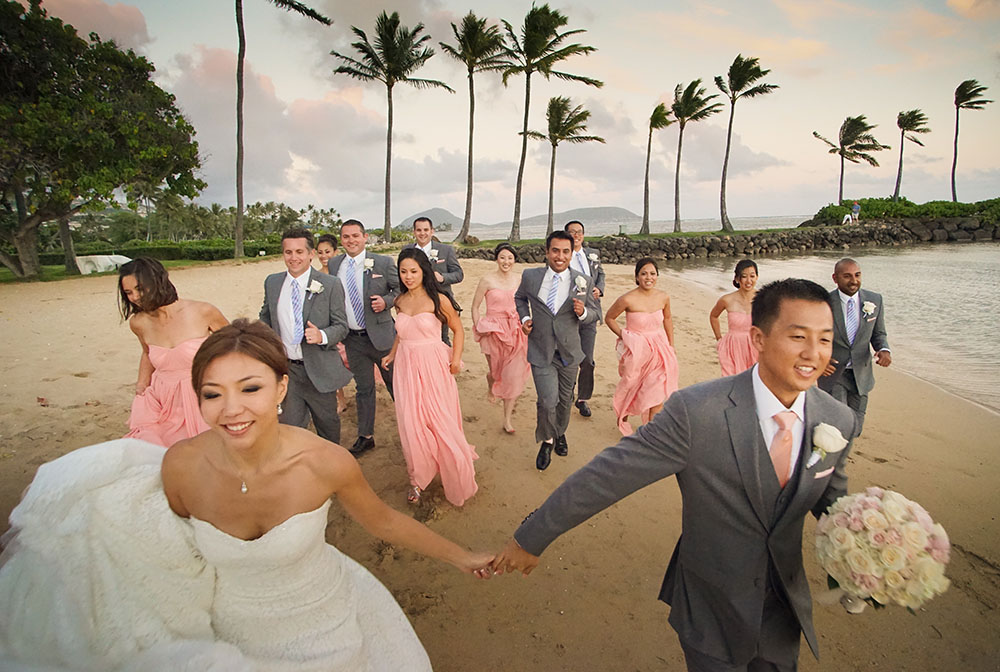
Photographed with a Sony a7 and Zeiss® Planar T* 20mm f/1.4 ZA lens at ISO 6400 with an f/8.0 aperture and 1/320 second shutter speed. Photo © Scott Robert Lim.
AB: Do you think beginners focus too much on taking each shot instead of capturing the overarching narrative of the day?
Scott Robert Lim: The experienced photographer will shoot a photo and say, “I ain’t clicking again until I get something better than what I just shot.” The new wedding photographer will just start shooting like crazy. So what happens is that you end up having 2,000 or 3,000 shots, and you’re creating more work for yourself, because you have to cull all of those shots. You have to pick out the good ones for your clients.
When you shoot a wedding, you’re shooting for the album. So you have to ask: Would the bride and groom want that photo in an album? If you’re going to take another shot, is that next shot really better than the shot you just took? If not, don’t take it. Because you can get so busy and focused on looking at one little area through your viewfinder that you’re not pulling back and with both eyes looking around at what’s happening. Maybe if you were to just step back and look four feet to your right, there could be an amazing moment right there that you missed.
AB: What allows you to do your best work when you’re shooting a wedding?
Scott Robert Lim: I think it’s when you develop a relationship with your clients and they trust you, and they’re having a good time with you. They’re buying into who you are and what you’re doing, and it’s a teamwork type of thing. You feel like, “Hey, we’re in this together.” There’s this synergy that happens, and things come together.
Those are the best weddings. It’s not about where you are—even if you’re at the Amalfi coast or in Paris. It’s about the relationship you establish with your clients, when you feel like you’re in a groove. You’re doing your job at a very high level and they’re having a great time, and you can’t miss. That’s why you get paid the big bucks—when you create that and you can do it on a consistent basis, you can have a very long career in wedding photography.
This interview was made possible by support from Sony's Artisans of Imagery program. For more about Scott Robert Lim, visit his website or find him on Sony's Alpha Universe site.
Want to read more interviews like this one? Check out our other Sony Artisans of Imagery interviews below:
Chasing moonbows: Tips on working with extraordinary light from landscape photographer Don Smith
Fast, far, and wide: Tips for intrepid photographers from adventure sports shooter Gabe Rogel
Background first; the subject can wait: Unusual advice from Nat Geo pro Ira Block
No truth in photography? Photojournalist Ben Lowy on making (not taking) images